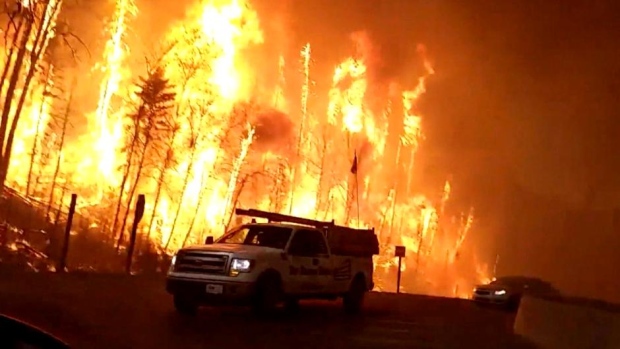May 6, 2016
Oil output plummets as Fort McMurray wildfire spreads

The Alberta wildfire that has destroyed entire neighbourhoods in Fort McMurray took a growing toll on the energy industry on Thursday, forcing as much as a quarter of the country’s oil output off line.
Oil sands projects, pipelines and electrical facilities around Fort McMurray have shut down and workers have been sent to safer locales.
Alberta oil sands faces production challenges with 'pressured' work force (The Globe and Mail)With the inferno having expanded by more than tenfold in a day, there is no estimate yet on when many of the operations can resume.
Northern Alberta’s fiery disaster, and fears of a worsening supply problem, prompted global oil traders to bid crude prices up, though they pared gains by the end of the session. U.S. benchmark West Texas intermediate rose 54 cents (U.S.) to settle at $44.32 a barrel. Prices for Canadian heavy oil and light synthetic crude derived from the oil sands also rose on tightening supplies.
If operations can get back on line relatively quickly, as was the case last year when wildfires caused outages far south of Fort McMurray – and if there is no damage to facilities – the market impact should be relatively small, said Jackie Forrest, vice-president at ARC Financial.
“The thing is we’re not certain it’s going to stay that way. It could be that this fire grows and that we actually see some damage to oil sands facilities that isn’t temporary,” Ms. Forrest said.
Estimates place the volume that companies have shut off at between 800,000 and one million barrels a day. Prices have yet to spike dramatically, largely because the outages come at a time of brimming inventories in North America. No companies are estimating when evacuated staff can return from shelters and other temporary housing around the province.
The disaster follows months of economic turmoil in the once-booming region, which had been hit hard by project cancellations and mass layoffs in the oil sands due to the global oil-price collapse.
Alberta Premier Rachel Notley said on Thursday the fire had expanded to 85,000 hectares, more than 10 times the size of just 24 hours earlier. It also took a southerly path, forcing evacuations in the Anzac area south of Fort McMurray. The day before, as Fort McMurray’s situation worsened, more than 80,000 people fled.
Suncor Energy Inc. said late on Thursday it had halted output at its steam-driven MacKay river and Firebag sites due to related pipeline shutdowns. The facilities produced a combined 235,800 barrels per day in the first quarter. The company said there is no damage to the facilities.
Imperial Oil Ltd. said late Thursday it reduced staffing and production at its Kearl oil sands project by undisclosed numbers. Kearl, located well north of the city, produced an average of 194,000 barrels of bitumen a day in the first quarter. “This action was taken to conserve critical supplies as we manage uncertainties associated with inbound and outbound logistics,” the company said in a statement.
Meanwhile, Athabasca Oil Corp. shut down its Hangingstone steam-driven oil sands plant, which is south of Fort McMurray, and was in the process of evacuating workers, as fire approached within 5 kilometres, the company said. It had been producing about 8,000 barrels a day.
Early Thursday, ConocoPhillips halted operations at its Surmont steam-driven oil sands development, and evacuated both staff and Fort McMurray residents who had taken up shelter at its work camp. Surmont, a 50-50 joint venture with France’s Total SA, produced a total of 50,000 barrels a day in the first quarter of 2016, based on a net figure of 25,000 provided by ConocoPhillips.
Nexen Energy ULC, a unit of China’s state-run CNOOC Ltd., shut its nearby Long Lake oil sands facility, which had produced 50,000 barrels a day.
Those moves followed outages at major operations run by Royal Dutch Shell PLC and Suncor Energy Inc. and scaled-back output at Syncrude Canada Ltd. and Husky Energy Inc., among others. Shell produces 255,000 barrels a day at its oil sands operation, and Suncor has a capacity of 350,000 at its base plant.
There were no reports of energy facilities being damaged.
Cenovus Energy Inc. said all but essential staff had been sent away from its Christina Lake oil sands plant as a precaution, citing a high risk of wildfire in the area. The operation is more than 100 kilometres south of fires to the north, and production remained unaffected, it said.
Once blazes are extinguished, staffing at projects is expected to become a problem with hundreds of homes in Fort McMurray destroyed, RBC Dominion Securities analyst Greg Pardy said in a research note. It will necessitate such solutions as more fly-in, fly-out labour, he said.
Canadian Natural Resources Ltd. runs the Horizon oil sands mining operation north of the city, and several steam-driven bitumen and heavy oil projects to the south. Its chief executive officer, Steve Laut, said the company’s output “remains stable.”
He noted that 78 per cent of Horizon staff are flown to the company’s own airport and therefore are not affected by evacuation. It has sent 1,400 non-essential employees out of the area and was housing evacuees at camps, though provincial officials said efforts had begun to move people out of northern areas to facilities with more services.
Numerous regional pipelines have shut down, including those operated by Inter Pipeline Ltd. and Pembina Pipeline Corp., as oil sands facilities tapered production.
Enbridge Inc. said it shut down its Cheecham terminal and removed employees, and reduced staff at its Athabasca terminal to a minimum. As a result, related pipelines were taken off line.
Enbridge has about 6.9 million barrels of oil storage associated with its Athabasca regional operations in northern Alberta, including about three million at its Athabasca Terminal and about 2.3 million at its Cheecham, according to the company’s website.
With a report from Shawn McCarthy in Ottawa









